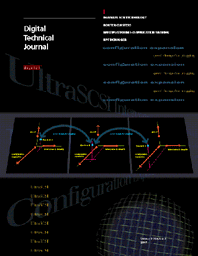|

Jane C. Blake,
Managing Editor
This issue of the DIGITAL Technical Journal presents papers on a range of
computing subjects, beginning with recent advances in storage technologies, followed by
network router cluster enhancements, new desktop software for sharing 3-D applications
across platforms, and an experimental High Performance Fortran debugger.
DIGITAL’s storage engineers have been leaders in the definition of the parallel
small computer system interface (SCSI) ANSI standards and in related technology
improvements. Bill Ham’s paper focuses on four advances in the physical features of
SCSI that resulted in major increases in SCSI capabilities and minor disturbances when
incorporated in existing installations. The discussion spans developments from SCSI-2
through UltraSCSI, including speed increases in the synchronous data phase; longer, more
complex configurations enabled by bus expanders; physical versatility inherent in a
decreased size of the interconnect; and dynamic removal and replacement of devices on an
active bus (hot plugging).
The subject of our next paper is networks, and the emphasis of the engineering is on
customer requirements for reliability and availability. Router clusters, described here by
Peter Higginson and Mike Shand, were developed to provide fast failover response in IP
networks and are defined as a group of routers on the same local area network (LAN)
providing mutual backup. New router cluster protocols and mechanisms restrict the loss of
service that results from a failure on the network, specifically on networks requiring
high availability, such as telecommunication and stock exchange networks. The authors
analyze failure cases and present the solutions that reduced service-loss time from
approximately 30 to 45 seconds to 5 seconds in both LAN and WAN environments.
Collaboration software for desktop systems can be broadly defined to encompass a range
of capabilities, from a simple transfer of data between users, such as e-mail sent over a
network, to real-time sharing of text, graphics, and audio and video data. Larry and Ricky
Palmer have designed a software product, called Shared Desktop, for users who want to
share three-dimensional graphics applications and audio across networks. Notably, the
design differentiates itself by supporting multiple operating systems, currently enabling
real-time interoperation among Windows and UNIX systems. The authors discuss the decision
to create a "viewport," which is a part of the desktop screen, and issues they
addressed during implementation, including protocol splitting, screen capture and data
handling, and dissimilar frame buffers. They conclude with ideas for possible enhancement
of the product in the future.
In a previous issue of the Journal featuring technical computing topics (vol. 7
no. 3), Jonathan Harris et al. described DIGITAL’s Fortran 90 compiler that
implements High Performance Fortran version 1.1, a language for writing parallel programs.
An outgrowth of that work is an experimental debugger, code-named Aardvark, that
"reconstructs" for the HPF programmer a single source-level view, even though
the program has several flows of control and the data are distributed. David
LaFrance-Linden discusses the challenges faced in creating the debugger and describes
useful techniques and concepts, such as logical entities, that can be generally applied to
debugger design.
Readers interested in past issues of the Journal are invited to visit the Journal
Web site at http://www.digital.com/info/dtj.
Our next issue will address such topics as optimization of NT executables on Alpha, a new
graphics program, and VLM. A Special Issue on programming languages and tools is being
developed for publication in the fall of 1998.
|
|